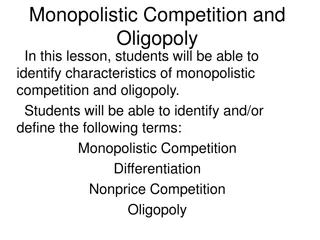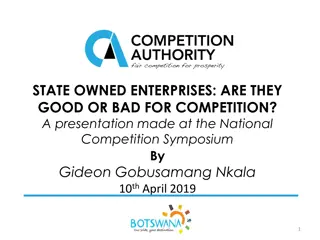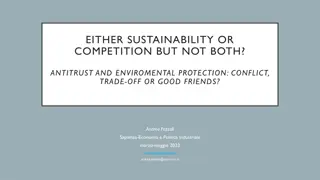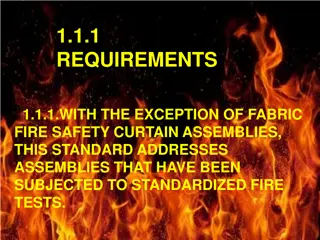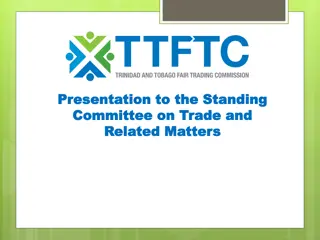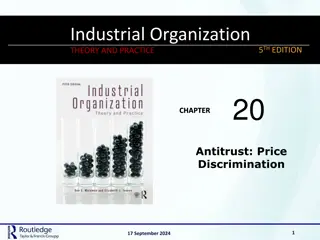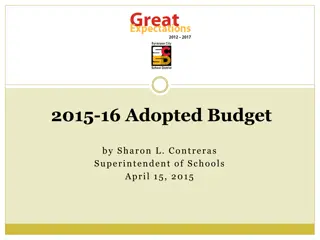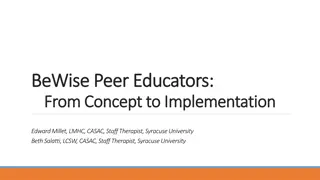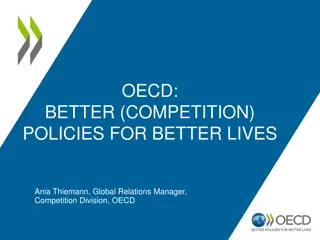Competition and Policy Analysis at Syracuse University
The documents cover various aspects of a competition and policy analysis at Syracuse University, focusing on addressing the high dropout rate. It includes data on competition results, proposed policies, societal problems, and implementation responsibilities. The content emphasizes the need to increase scholarship assistance for sophomores with a GPA above 3.0.
Download Presentation

Please find below an Image/Link to download the presentation.
The content on the website is provided AS IS for your information and personal use only. It may not be sold, licensed, or shared on other websites without obtaining consent from the author.If you encounter any issues during the download, it is possible that the publisher has removed the file from their server.
You are allowed to download the files provided on this website for personal or commercial use, subject to the condition that they are used lawfully. All files are the property of their respective owners.
The content on the website is provided AS IS for your information and personal use only. It may not be sold, licensed, or shared on other websites without obtaining consent from the author.
E N D
Presentation Transcript
"Spoon-feeding, in the long run, teaches nothing but the shape of the spoon." ~EM Forster Benchmarking Benchmarking 0 100
Competition Points Groups Points 9 2 8 12 10 17 15 18 1 5 11 7 16 3 13 19 6 14 20 4 35 33 30 29 28 28 27 27 26 26 26 25 25 24 24 24 23 23 23 21 Winners Losers As of 11/1/19
Class Agenda Class Agenda Announcements Dale Carnegie Competition Debriefing
Competition Results Competition Results Group 16 won and got 5 points. The following groups received no points: Group 3, 13, and 17 All other groups got 3 points.
Module 4 Competition Module 4 Competition Problem: Problem: The dropout rate at Syracuse University in Syracuse, New York is too high. Proposed Policy: Proposed Policy: Increase all scholarship assistance to sophomores with a GPA above a 3.0 by $2,000.
Competition Data Competition Data School Year First Year Drop Out Rate 2016-2017 7.6% 2017-2018 8.3% 2018-2019 9.9% 2019-2020e 9.1% Source: Office of Institutional Research and Assessment
Exercise 7.1 and 7.2 Exercise 7.1 and 7.2 State your societal problem here (make sure to specify geographic location): Drop out rates Restate the proposed policy here to deal with this societal problem and who enacts it here: Increase all scholarship assistance to sophomores with above a 3.0 GPA by $2,000. This will be enacted by the Syracuse University Board of Trustees. Identify the primary unit responsible for implementing this policy: Syracuse University Department of Public Safety
Exercise 7.1 and 7.2 Exercise 7.1 and 7.2 State your societal problem here (make sure to specify geographic location): Drop out rates Mistake 1: Mistake 1: Not stated as a societal problem. No too much/too little. Mistake 2: Mistake 2: No geographic location. Correct: Correct: The first-year drop out rate at Syracuse University in Syracuse, NY is too high. Restate the proposed policy here to deal with this societal problem and who enacts it here: Increase all scholarship assistance to sophomores with above a 3.0 GPA by $2,000. This will be enacted by the Syracuse University Board of Trustees. Bullet 2: Bullet 2: Correct Identify the primary unit responsible for implementing this policy: Syracuse University Department of Public Safety Mistake 3: Mistake 3: Wrong primary unit. DPS does not play a role in implementing financial policy Correct: Correct: Office of Financial Aid
Exercise 7.1 and 7.2 Exercise 7.1 and 7.2 List the most significant benefit and cost of the proposed policy and assign a rating of significance of 1, 2, or 3 to each item. Justify each rating you have assigned in no more than two sentences. List and explain the most significant benefit here: Students can spend their money at DJ s Rating (1-3): 3 Justification for rating: SU is the number one party school, so they want to keep their ranking. List and explain the most significant cost here: SU spends more money on financial aid Rating (1-3): 1 Justification for rating: This will not cost a lot.
Exercise 7.1 and 7.2 Exercise 7.1 and 7.2 List the most significant benefit and cost of the proposed policy and assign a rating of significance of 1, 2, or 3 to each item. Justify each rating you have assigned in no more than two sentences. List and explain the most significant benefit here: Students can spend their money at DJ s Rating (1-3): 3 Justification for rating: SU is the number one party school, so they want to keep their ranking. Mistake 2: Mistake 2: Incorrect justification. Should justify WHY you chose the rating (1, 2, 3) rather than why the benefit or cost is listed. Correct: Correct: I give this benefit a 3 because this is the goal of the policy. Mistake 1: Mistake 1: Most obvious benefit not listed Correct: Correct: The dropout rate will decrease. List and explain the most significant cost here: SU spends more money on financial aid Rating (1-3): 2 Justification for rating: This will not cost a lot. Mistake 3: Mistake 3: Weak justification. Also, this justification is not true because spending more money would cost more. Correct: Correct: I give this cost a 2 because the high cost is a burden on the university.
Exercise 8.1B Exercise 8.1B Provide data for four years on a variable measuring your societal problem. Refer to Chapter 8. Drop Out Rate Time Period [Number of Variable] 7.6% Source or Rationale for Estimation 2017 Office of Institutional Research and Assessment 2018 8.3% Office of Institutional Research and Assessment 2019 9.9% Office of Institutional Research and Assessment 2020e 9.1% Because the bar, Harry s, is closing.
Exercise 8.1B Exercise 8.1B Provide data for four years on a variable measuring your societal problem. Refer to Chapter 8. Mistake 1: Mistake 1: Incomplete title. Mistake 2: Mistake 2: No specific variable within the brackets. Drop Out Rate Time Period [Number of Variable] 7.6% Source or Rationale for Estimation Mistake 3: Mistake 3: Should be in academic years and indicate which years are estimate. 2017 Office of Institutional Research and Assessment 2018 8.3% Office of Institutional Research and Assessment 2019 9.9% Office of Institutional Research and Assessment Mistake 4: Mistake 4: Incorrect rationalization. A bar closing will not bring down drop out rates by .8% 2020e 9.1% Because the bar, Harry s, is closing.
Exercise 8.1B (Cont.) Exercise 8.1B (Cont.) Provide data for four years on a variable measuring your societal problem. Refer to Chapter 8. First-Year Drop Out Rate at Syracuse University in Syracuse, NY (2016-2020e) Time Period Percentage of Drop Outs 7.6% Source or Rationale for Estimation Office of Institutional Research and Assessment 2016-2017 Office of Institutional Research and Assessment 2017-2018 8.3% Office of Institutional Research and Assessment 2018-2019 9.9% 2019-2020e 9.1% In three previous years it increased so much that it will stay high but will regress in the direction of the mean.
School Year Drop Out Rate Exercise 8.2A Exercise 8.2A 2016-2017 7.6% 2017-2018 8.3% 2018-2019 9.9% 2019-2020e 9.1% Using the formula presented in Chapter 8, calculate the percent change between the first and second year of the data presented in the beginning of this competition. Write the percent change here: -8.1% Show the original formula and your calculations here: [(new figure-old figure)/old figure] x 100 = percent change [(9.1-9.9)/9.9] x 100 = -8.1%
School Year Drop Out Rate Exercise 8.2A Exercise 8.2A 2016-2017 7.6% 2017-2018 8.3% 2018-2019 9.9% 2019-2020e 9.1% Using the formula presented in Chapter 8, calculate the percent change between the first and second year of the data presented in the beginning of this competition. Write the percent change here: -8.1% Mistake 1: Mistake 1: Incorrect calculation. Show the original formula and your calculations here: [(new figure-old figure)/old figure] x 100 = percent change [(9.1-9.9)/9.9] x 100 = -8.1% Mistake 2: Mistake 2: Incorrect calculation. Uses data points for the last two years instead of the first two years. Correct Calculation: Correct Calculation: [(8.3 7.6) / 7.6] X 100 = 9.2%
Exercise 8.3 Exercise 8.3 State what three years for which you would set your benchmark for to compare your baseline data. Briefly indicate why you have chosen those years. State what three years you set your benchmark for here: oFirst year: 2020-2021 oSecond year: 2021-2022 oThird year: 2023-2024 Briefly justify here: Because those were the next three years.
Exercise 8.3 Exercise 8.3 State what three years for which you would set your benchmark for to compare your baseline data. Briefly indicate why you have chosen those years. State what three years you set your benchmark for here: oFirst year: 2020-2021 oSecond year: 2021-2022 oThird year: 2023-2024 Mistake 1: Mistake 1: Incorrect spacing of years. Need consistent intervals. Briefly justify here: Because those were the next three years. Mistake 2: Mistake 2: Poor justification. Doesn t discuss the expected rapidness/slowness of the policy s effect and how the years show how fast or slow the changes will occur. Correct: Correct: The policy s effects on the dropout rate will be seen immediately, so three consecutive years after implementation will be enough time to see the changes.
Exercise 8.4 (Graph) Exercise 8.4 (Graph) Place a trend line graph below that displays your historical data and your baseline forecast for the three years selected in 8.3. 12.0% 9.9% 10.0% 9.1% 8.3% 7.6% 8.0% 6.0% 4.0% 2.0% 0.0% 2016 2017 2018 2019 2020 2021 Historical Baseline
Exercise 8.4 (Graph) Exercise 8.4 (Graph) Place a trend line graph below that displays your historical data and your baseline forecast for the three years selected in 8.3. Historical and Forecast Graph for First Year Drop Out Rates at Syracuse University: 2016-2023f Mistakes: Mistakes: 1. 2. No axes titles Missing data labels No graph title Only forecasted 2 years (need 3) No source Include e for estimates and f for forecasts X-axis wrong years 12.0% 10.7% 10.5% Percentage of First Year Drop Outs 9.9% 9.9% 3. 4. 10.0% 9.1% 9.1% 8.3% 7.6% 8.0% 5. 6. 6.0% 4.0% 7. 2.0% 0.0% 2016-2017 2017-2018 2018-2019 2019-2020e 2020-2021f 2021-2022f 2022-2023f Academic Years Historical Baseline Source: Syracuse University Department of Institutional Research * *DISCLAIMER: Do not make your graph in your module red!!!!!!!!!!!!!
Exercise 8.4 (Justification) Exercise 8.4 (Justification) Write a clear justification of your forecast by using the ideas discussed in 8.4 of the chapter here: The forecast follows the same pattern as the historical data that shows an increase in the dropout rate. Assume the pattern will be similar to the years you are forecasting.
Exercise 8.4 (Justification) Exercise 8.4 (Justification) Write a clear justification of your forecast by using the ideas discussed in 8.4 of the chapter here: The forecast follows the same pattern as the historical data that shows an increase in the dropout rate. Assume the pattern will be similar to the years you are forecasting (Coplin, 2017, p. 97). Mistake 1: Mistake 1: Missing internal citation
Helpful Hints Helpful Hints Be sure to justify the rating (1, 2, 3) you give the benefit or cost rather than why the benefit or cost is listed. Benchmarks can only be set for the years AFTER the policy is implemented. Label forecasted and estimated data points! Be realistic with your benchmarks. Just because a policy is implemented does not mean a societal problem will be ameliorated. Put a title on data charts (Ex. 8.1)
For Next Class For Next Class Module 4 due 11/2 Second Debriefing on Wednesday 11/2





